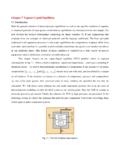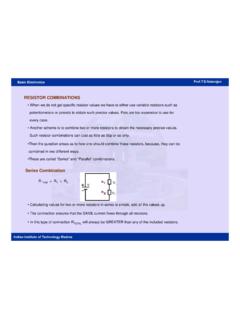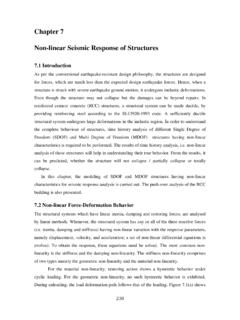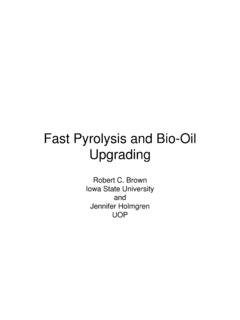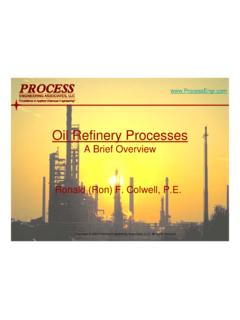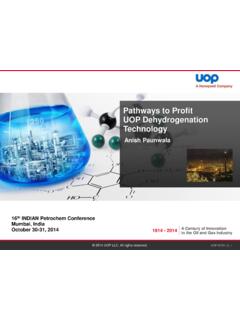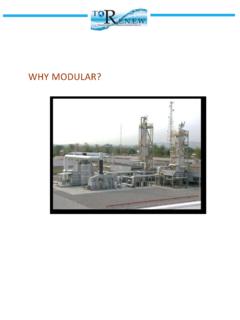Transcription of Lecture 7 Aromatic Production - NPTEL
1 Course: Chemical Technology (Organic) Module VII. Lecture 7. Aromatic Production Lecture 7. Aromatic Production . Aromatic hydrocarbons especially benzene, toluene, xylene, ethyl benzene are major feedstock for a large number of intermediates which are used in the Production of synthetic fibers, resins, synthetic rubber, explosives, pesticides, detergent, dyes, intermediates, etc. Styrene, linear alkyl benzene and cumene are the major consumer of benzene. Benzene also finds application in the manufacture of a large number of Aromatic intermediates and pesticides. As per CMAI, demand for benzene is forecast to grow at an average annual rate of per year through 2020 resulting in nearly 57 million tonnes of demand by 2020.
2 Originally, the aromatics were produced from coal tar distillation, which is the by-product of destructive distillation (carbonisation). Major application of toluene is as solvent. Other uses are in the manufacture of benzoic acid, chloro derivatives, nitro toluenes, toluene sulphonic acid, toluene sulphonamide, benzaldehyde, etc Xylenes are another important aromatics. Various sources of aromatics is mention in Table M-VII Amongst the xylenes, about 80% of the Production is of p-xylene. Finds application in the manufacture of terephthalic acid/DMT. o-Xylene used in the manufacture of phthalic anhydride and m-xyleneIsohthalic acid.
3 Typical yield of benzene, toluene, xylene in kg per tonne of coal carbonised is about , , and kg [Wiseman, 1986]. Table M-VII : Various Sources of Aromatics Processes Description Coal Carbonisation From coke oven plant during carbonisation, light oil is obtained as by (Coke oven plant) product which contains about 2-8 kg, kg, kg of benzene, toluene and xylene respectively per tonne of coal. Steam cracking of Steam cracking of naphtha and light hydrocarbon like ethane and propane hydrocarbons produce liquid product (pyrolysis gasoline) rich in aromatics containing about 65% aromatics about 50% of which is benzene.
4 About 30-35% of benzene produced worldwide is from pyrolysis gasoline. 353 Catalytic Reforming Catalytic reforming is a major conversion process, which converts low octane naphtha to high-octane gasoline and produce aromatics rich in BTX. Major reactions involved are dehydrogenation of naphthalenes to aromatics, isomerisation of paraffins and naphthenes, dehydrocyclisation of paraffins to aromatics, and hydrocracking of paraffins. BP-UOP Cyclar Process In this process, BTX is produced by dearomatisation of propane and butane. The process consists of reaction system, continuous regeneration of catalyst, and product recovery.
5 Catalyst is a proprietary zeolite incorporated with a non noble metal promoter. Dearomatisation of Process consists of extraction of aromatics from high Aromatic naphtha feed naphtha without prior reforming. The process is useful for naphtha having high aromatics. Hydro dealkylation and Hydrodealkylation: It involves Production of benzene by dealkylation of disproportionation toluene either by catalytic or thermal process. Catalytic process: Hydeal, Deltol Thermal process: HAD (ARCO), THDC Gulf Oil Disproportionation: It involves conversion of toluene into benzene and xylenes. This process consists of conversion of C8 stream into valuable o- and p- xylene having isomerisation and isomer separation stage.
6 Mitsubishi's Zforming This process uses metallosilicate zeolite catalyst to promote Process dehydrogenation of paraffins followed by oligomerisation and dehydrocyclisation of paraffins followed by oligomerisation. KTI Pyroforming This process uses a shape selective catalyst to convert C2 and C3paraffins to aromatics. Cheveron'sAromax It is similar to conventional catalytic reforming processes and L-type zeolite process catalyst. Isomerisation and This process consists of conversion of C8 stream into valuable o- and p- Isomer process xylene having isomerisation and isomer separation stage. 354 Mitsubishi's Zforming This process uses a metallosilicate zeolite catalyst to promote Process dehydrogenation of paraffins followed by oligomerisation and dehydrocyclisation of paraffins followed by oligomerisation.
7 KTI Pyroforming This process uses a shape selective catalyst to convert C2 and C3 paraffins to aromatics. Cheveron'sAromax It is similar to conventional catalytic reforming processes and L-type zeolite process catalyst. Source: Mall. 2007. CATALYTIC REFORMING. Catalytic reforming is a key conversion process in a petroleum and petrochemical industry. The catalytic reforming gives flexibility to meet gasoline octave number requirement. It can also make aromatics of high market value. Catalytic reforming is a refining process that uses selected operating conditions and selected catalysts to convert.
8 Basic objective of catalytic reforming is To produce high octave blending stock for motor fuel To produce high value Aromatic hydro carbon such as BTX. Process Description A typical catalytic reforming process includes following three sections: Naphtha Hydrotreating Catalytic Reforming Catalyst Circulation and Regeneration Basic steps in catalytic reforming involve feed preparation, temperature control, reaction in reformer and product recovery, various types of catalytic reformer are semi regeneration, non- regeneration cyclic moving bed two types of reformer reactors are in use radial flow and axial flow.
9 Details of this has been covered in Module VI Lecture 6. Reactions in Catalytic Reforming Process Number of reactions takes place in catalytic reforming. Dehydrogenation is one of the major reactions. these reactions are discussed in detail in module VI Lecture 6 Some of the major reactions are Dehydrogenation Methyl Cyclohexane Toluene + H2. 355 MCP Benzene + H2. Isomerisation n-Hexane Neohexane Dehydrocyclisation of paraffins, i-paraffins to aromatics n-heptance Toluene + H2. Hydrocracking BTX FROM PETROLEUM. Major Units of Aromatic Complex Heavy Naphtha Pretreatment Unit Catalytic reforming (Platformer Unit,CCR Unit Continuous Catalyst Regenerator).
10 Recovery Plus PSA (Pressure Swing Adsorption). BTX separation Xylene Fractionation Unit for separation of o-xylene from m- and p- xylene p-xylene and m-xylene separation by crystalisation, adsorption Process steps in Aromatic Production : Figure M-VII gives the details description of aromatics complex. The various steps involved in Aromatic Production are given below: First step in making BTX is to distill off a suitable fraction rich in natphthenes which serves as precursors for aromatics Catalytic reforming or a team cracking to produce an Aromatic gasoline. Detail of the catalytic reforming is given in Lecture 6 , Module VI Lecture 6 , Preliminary treatment of this cut: fractionation and /or selective hydrogenations essentially pyrolysis gasoline Solvent extraction to eliminate non- Aromatic from aromatics Distillation to produce pure benzene and toluene and in cased reformates used alone or blended art a pyrolysis gasoline, the following additional treatment Distillation Aromatic C8 to yield by super fractionation ethyl benzene and O-xylene, after passage through a separation column in a light cut and a heavy cut (splitter).

